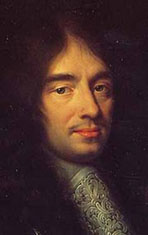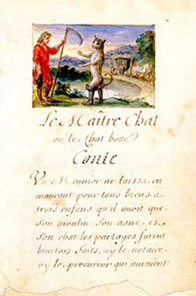
Charles Perrault
1665

(A page from a late 17th century handwritten and illustrated version of Charles Perrault's Contes de ma mère l'Oye (Stories of Mother Goose).)
Historie
(Nederlands)
History (English)
In 1697 publiceerde hij 'Histoires ou contes du temp passé, avec des moralités: Contes de ma mère l'Oye' (Verhalen of sprookjes uit de verleden tijd, met de subtitel Verhalen van Moeder de Gans). Aanvankelijk publiceerde Perrault deze sprookjes onder de naam van zijn zoon Pierre. Le Maitre Chat ou Le Chat Botté (De Gelaarsde Kat) maakt er deel van uit. De publicatie maakte hem meteen wijd en zijd bekend buiten zijn eigen kring.
Klik hier voor een Nederlandse vertaling van de meest originele versie die ik tot nu gevonden heb.
De vroegste vertaling in het Nederlands dateert pas uit 1754. Bij de Haagse libraire Pieter van Os verscheen het tweetalige 'Contes de ma mère l'Oye. Vertellingen van Moeder de Gans' met kopergravures door Simon Fokke. Dat het even geduurd eer er een Nederlandse versie verscheen heeft te maken met het feit dat in 'hogere' kringen veel Frans gesproken werd. Een vertaling was dus niet direct nodig. Van deze uitgave zijn slechts 3 exemplaren bekend, nl. in de Koninklijke Bibliotheek in Den Haag, in het Openluchtmuseum te Arnhem en in een particuliere collectie.
Perraults verhalen worden nog steeds gedrukt en zijn verwerkt in opera's, toneelstukken, films etc.
Maar het verhaal van
de listige kat bestond al een paar eeuwen voordat Perrault met zijn
versie kwam.
Hij voegde er elementen uit zijn eigen belevingswereld aan toe en gaf
het een 'happy end', waardoor het verhaal 'toegankelijk' werd voor de
hogere kringen. Hij maakte het verhaal als literatuur geaccepteerd. De volkswijsheid uit de oorspronkelijke versie was
hiermee verdwenen.
Een Italiaanse
variant van het verhaal,
'Contantino
Fortunato', verschijnt in Straparola's Piacevole Notti in de 16e eeuw
(ca. 1550-3). De meeste deskun-digen menen dat Giovani Fransesco Straparola
(1480-1557) zijn verhaal
ontleende aan mondelinge folklore. Maar er is geen bewijs dat het
sprookje al eerder bestond.
Piacevole Notti werd voor het eerst in 1894 in het Engels uitgegeven
door Lawrence Bullen, London met de titel The Nights.
Giambattista Basile (1566 or 1575–1632), een Italiaanse dichter, hoveling en sprookjes verzamelaar, voegde ook een verhaal van een arme jongen Gagliuso met een slimme kat (Lo cunto de li cunti) toe aan zijn Il Pentamerone (ca. 1634-1636).
Klik hier voor mijn vertaling van een originele Engelse vertaling van Gaglioso en zijn kat.
The gebroeders
Jakob (1785–1863) and Wilhelm Grimm (1786–1859) voegden ook een verhaal
van De Gelaarsde Kat toe aan hun eerste collectie van volkssprookjes
Sprookjes voor kind en gezin (Kinder- und Hausmärchen),
maar verwijderden het later in 1819 omdat het te veel leek op Perraults
versie. Zij gebruikten een verhaal van Jeannette Hassenpflug en
elementen uit het
'Märchenspiel' Der
gestiefelte Kater, ein Kindermärchen in drey Akten (1797) van Ludwig
Tieck (1773-1853).
In de publicatie van 1819 komt het volgende verhaal voor:
Klik
hier
voor mijn vertaling van het latere sprookje
van de gebroeders Grimm.
In dit verhaal heeft de kat geen laarzen aan. Toch wordt het sprookje
van De Gelaarsde Kat (in de versie van Perrault) vaak toegedicht aan
de gebroeders Grimm.
Het verhaal wordt gevonden in alle delen van Europa, Siberia, India en
de Fillipijnen. Het reisde ook met kolonisten en reizigers uit Europa
mee naar Afrika en de Indianen in Amerika. Hoe verder weg van Centraal
Europa, hoe meer variaties er verschijnen in de welbekende litaraire
versie. Het grootste probleem is om variaties in het verhaal te
onderscheiden van andere verhalen over hulp uit de dierenwereld. Het
wordt moeilijk om uit te maken welke verhalen deel zijn van De Gelaarsde
Kat en welke onafhankelijke creaties zijn.
Charles Perrault (January 12, 1628 - May 16, 1703) was born in Paris (France) to a wealthy bourgeois family. He studied law before embarking on a career in government service. He was member of the Académie Francais and an important intellectual.
In 1697 he published
'Histoires ou contes du temp passé,
avec des moralités: Contes de ma mère
l'Oye' (Tales
and Stories of the Past with Morals, with the subtitle: Tales of Mother
Goose). Perrault actually published these stories under the name of his
son Pierre. Le Maitre Chat ou Le Chat Botté (The Mastercat or Puss in Boots) is part of them. The publication
made him suddenly widely-known beyond his own circles.
Click
here for an English transalation of
the most original version I found up till now.
Perrault's stories are still in print today and have been made into operas, plays, movies and so on.
But the story of the trickster cat preceded Perrault's
tale by a few centuries.
He added elements from his own
'world'
and gave it a happy ending, whereby the story became 'accessible' to the
upper class. He gave the tale literary legitimacy. Herewith the peoples' wisdom disappeared from the original
version.
A Italian variant of the story, 'Constantino Fortunato',
appears in Straparola's Piacevole Notti in the sixteenth century (ca.
1550-3). Most scholars think that Giovani Fransesco Straparola
(1480-1557) derived his story from oral
folklore. But there is no evidence that this fairy tale does have an
earlier origin.
Piacevole Notti was first published in 1894 in an English translation as
The Nights by Lawrence Bullen, London,
Giambattista Basile
(1566 or
1575–1632), an Italian poet, courtier, and fairy tale collector,
also
included a story about a poor boy Gagliuso with a trickster cat (Lo
cunto de li cunti) in his Il Pentamerone (ca.
1634-1636).
Click
here for an original English
translation of Gagliuso and his cat.
The brothers
Jacob (1785–1863) and Wilhelm Grimm (1786–1859) included also a story of
Puss in Boots in their first collection of folks fairy tales
Children's and Household
Tales (Kinder- und Hausmärchen), but later
removed it in 1819 due to its obviously close relationship to Perrault's
tale. They used a story
Jeannette Hassenpflug and elements from the
'Märchenspiel' Der
gestiefelte Kater, ein Kindermärchen in drey Akten (1797) from Ludwig
Tieck (1773-1853).
In the publication of 1819 you will find the next story:
Click
here for
an original English translation of later the story by the brothers Grimm.
In this story the cat doesn't have boots on. Yet the fairy tale of Puss in Boots
is (in the version of Perrault) often ascribed to the brothers Grimm.
The
story has been found in all parts of Europe, across Siberia, onward to
India, Indonesia, and the Philippines. It also traveled with colonists
and travelers from Europe to Africa and the American Indians. The
further away from Central Europe, the stories take on more variations
from the well-known literary version. The greatest problem is distinguishing variations of the tale from other animal helper stories.
It is hard to determine which stories are part of the Puss In Boots
tradition and which are independent creations.
Bronnen
- English text (Retrieved from):
http://www.en.wikipedia.org/wiki/Perrault
http://www.en.wikipedia.org/wiki/Giambattista_Basile
http://www.surlalunefairytales.com/pussboots/history
http://www.surlalunefairytales.com/pussboots/index.html
(tekst sprookje met verklarende aantekeningen - text fairy tale with
annotations)
http://www.surlalunefairytales.com/pussboots/stories/gagliuso.html
http://www.verhalenbank.nl/lijst_lexicon.php?act=detail&volksverhaal_type=AT
0545B
If you found this page via your search on internet than is this the link to my website.